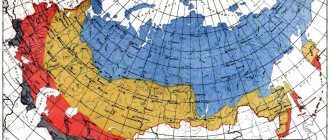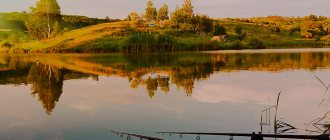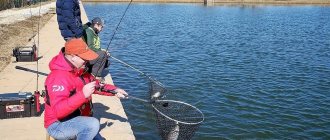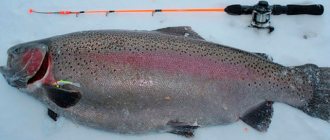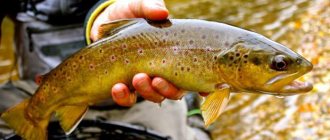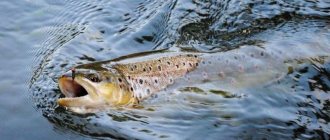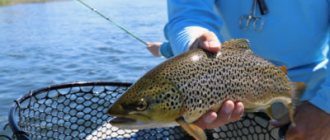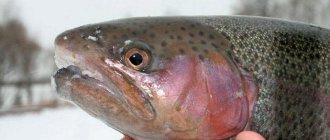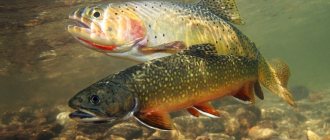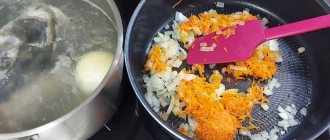When do rainbow trout spawn?
The time of year greatly influences trout spawning. Both species (brook trout, or trout, and rainbow, or mykiss) lay eggs strictly in certain months. For the rainbow subspecies, the breeding season is spring. Depending on the region, spawning can begin either in March or by the end of May. It is necessary that the water temperature is within 6-7 degrees Celsius. As soon as the required indicator is reached, the fish begins to reproduce.
It should be noted that rainbow trout spawn a little later than brook trout, at 3-4 years of age. Males reach sexual maturity by 3 years, females a year later.
Brook trout - who's who
Brook trout or “speckled trout” (Salmo trutta fario) is a freshwater form of “brown trout” belonging to the salmon family.
The term “trout” is a general term for many different species of fish of the salmon family, consisting of three genera. The large number of species of this family that are externally similar and close to each other creates confusion in the systematization of these animals.
Confusion regarding the relationship between brook, lake and anadromous (sea) trout has only been resolved in recent years. It has been established that all three forms belong to the same species - brown trout. Moreover, they easily move from one to another. Brook trout, acclimatized to the lower reaches of sea rivers, can easily slide into the sea, degenerating over time into anadromous brown trout, and also easily adapts to lake-type reservoirs.
Trout spawning areas
Trout spawning primarily occurs in shallow water. Females choose for laying eggs those sections of rivers that differ in depth up to 1 meter. Because of this, the entire process of procreation can be easily observed, especially in clear waters. In places where the bottom is covered with small pebbles up to 3 cm, spawning can occur even at great depths (up to 1.5 meters).
Females prefer places where the bottom is covered predominantly with small pebbles. Near large stones, spawning occurs only as a last resort, if a more suitable area has not been found.
Brook trout prefer areas of the river with stronger currents. It allows the fry to be carried away when they reach the age of independent feeding. Rainbowfish, on the other hand, lay their eggs in calmer waters. This is due to the characteristics of the eggs of the mykiss: they are almost not sticky, so they are easily carried away by the current without having time to fix themselves. This leads to the death of the embryos. In brown trout, fertilized eggs are sticky; they can attach to pebbles even in fast-moving rivers, for example, in Karelia.
River trout coloring
The color of river trout is very variable and largely depends on the composition of the water, soil, food supply, time of year and other factors.
We suggest you read: How to catch trout? Tips and little secrets!
The colors in the pied fish's outfit are more varied and rich on a bright sunny day; during spawning, the fish darken, briefly losing their beauty.
The back of river trout is most often greenish-brown, the sides are slightly yellowish with a slight copper tint, sometimes acquiring purple and bright pink tones. The grayish-white belly of the fish, closer to the tail, has a lemon color. Only it remains untouched by a scattering of multi-colored dots, surrounded by a light halo, covering the entire body, head and fins of the fish.
The color of the spots on the body of a trout is not typical; they can be either monochromatic or multi-colored: red, black, purple, etc.
How trout spawn (spawn)
As the spawning season begins, fish begin to move from lakes and ponds to rivers and large streams. She goes upstream, overcoming rapids up to 1.5 meters using jumps from the water. Females from 4 years old and males from 3 years old go to spawn. By this time, the females have ripened eggs, and, moving upstream, they look for the optimal place to lay them.
Article on the topic: TOP 10 winter lures for trout
Spawning occurs in shallow water. The female descends as close to the bottom as possible and creates a depression using her fins, nose and tail. She quickly lays several hundred eggs in this depression. Nearby males fertilize the clutch.
At the same time, the female may not allow weaker, younger representatives to approach her. Instinct kicks in: large individuals are perceived as more suitable for procreation.
To prevent the eggs from being carried away by the current, immediately after fertilization the female quickly buries them. This protects it not only from fast waters, but also from predators that can easily destroy the entire clutch. Pebbles additionally protect against external dangers.
The entire spawning process takes no more than a few minutes. The rainbow subspecies must bury the egg immediately, since its eggs do not have a sticky surface. The stream variety throws eggs with sticky outer walls, but this effect quickly disappears in water.
After 1.5-2 months in rainbow trout and after 2-3 in brook trout, fry appear from the eggs. They begin active life only after they have completely eaten the remains of the nutritious film of the eggs.
Article on the topic: Wobblers for trout
Biological features
This species has an elongated, slightly laterally compressed oblong body.
The surface of the body is covered with dense small scales. Trout is a cold-water fish. The optimal environmental parameters are water temperature 14-20 °C and oxygen content 7-8 mg/l.
Interesting fact. Although it is generally accepted that trout like cold water, they also feel comfortable in relatively warm water. The point here is not so much the temperature itself, but rather the sufficient amount of oxygen dissolved in the water. Trout are found in cold, deep-water lakes, both at great depths and near the shore, where the water is warmed by the sun.
Under natural conditions, the fish reaches about half a meter in length and 1-1.5 kg in weight. However, in large lakes there are specimens one meter long and weighing more than 8 kg. In rare cases, the life expectancy of rainbow trout can reach 11-12 years. Most trout live only 6-8 years.
The color of the body changes depending on the color of the bottom, the transparency of the water and the shade of the impurities it contains. Most often, the belly of the fish is silvery-white, and the back is greenish. There are numerous spots on the body and fins, with more of them above the lateral line, and closer to the abdomen they almost end.
We suggest you read: What do perch bite on? Where, how and when to catch perch
The color of the fish may vary depending on habitat conditions, spawning and general condition. In general, the young individual has silvery sides, the back is always darker than the sides.
The inhabitants of small lakes are paler and have fewer black spots. They are more silvery and almost devoid of the distinctive reddish stripe inherent in river and stream forms of fish.
Spawning
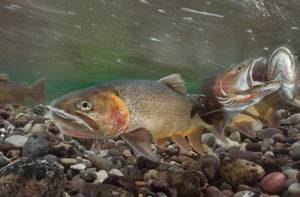
The most aggressive males that have passed the selection follow the female and immediately water the eggs with milk. The female fills the nests with fertilized eggs with fine gravel.
Puberty occurs at 3-4 years of age. Spawning occurs in the spring from mid-April to the end of June, but some populations can spawn in the fall, and fish can spawn during the day and at night. Trout caviar ranges in color from orange to almost pink. The eggs are quite large, their diameter is 4-6 mm.
First, the female makes peculiar nests in the ground, which look like depressions among the stones. Then she lays a certain number of eggs in each nest. In one nest there can be approximately from 500 to 10,000 pieces.
The most aggressive males that have passed the selection follow the female and immediately water the eggs with milk. The female fills the nests with fertilized eggs with fine gravel. After approximately 5 weeks, the first larvae begin to hatch from the eggs. After a few more days, the fry begin to leave the nest.
Nutrition
Rainbow trout is a voracious predator. Juveniles mainly feed on insects, and the menu of large individuals consists of fish (minnow, verkhovka, dace), frogs, small rodents and chicks of waterfowl.
The fish continue to feed, albeit with varying intensity, all year round. In summer, with the appearance of aerial insects, trout hunt mainly at the surface of the water. In winter, fish go to the depths, where their diet already consists mainly of bottom organisms, crustaceans, mollusks and insect larvae.
On a note! In trout farms, fish are accustomed to both natural and artificial feed. In such favorable conditions, it grows much faster and reaches large sizes.
At first, the fry stay and feed in schools, the number of which decreases as the fish grow older. Adults like to hunt alone, occupying certain areas of the reservoir and driving away other fish from there. When the food supply in the reservoir is scarce, the predator begins to migrate in search of a more suitable place.
Artificial spawning as business difficulties
Trout farming faces the problem of spawning every year. In artificial conditions, fish cannot spawn according to the standard pattern, since they do not have access to rivers and streams. All life activities take place in dams and fenced areas of lakes. Producers need to carry out the procedure of crossing males and females independently.
During the spawning period, the best representatives of the economy are selected: a certain number of females and 1.5-2 times more males. They must be at least 400 grams in weight, brightly colored, and active. The fish are placed in separate cages depending on their gender. There should be about 30 individuals per 1 cubic meter of water. When the eggs of the females ripen, they, as well as the males, are treated with soothing compounds. Eggs are taken from 2-3 females and placed in a common vat. She is then fertilized by the sperm of 3-5 males. For successful fertilization, you need to place water in a container and wait 3 to 5 minutes. The resulting clutch is then sent to the hatchery.
You can increase the fertility of fish and the speed of its development in sea water. If the producer wants to achieve year-round spawning of trout, it is necessary to regulate the water temperature within 4-11 degrees, and also combine the breeding of mykiss and brown trout.
Living conditions and sizes of trout
The maximum length of adult variegates ranges from 20 cm to 70 cm, with a weight from 300 grams to 6-7 kg, respectively, and a life expectancy of no more than 15-18 years. The size of brook trout depends on the size of the reservoir it inhabits and the food supply in it.
Thus, in small mountain streams that have not had time to merge together, trout rarely grow more than 25 cm, but in the foothills, where they carry their waters in a single stream, its size reaches 70 cm.
Brook trout belongs to the inhabitants of cold rivers, originating on the slopes of mountains and fed by glaciers and spring waters.
It is in such cold and flowing water, saturated with oxygen, that this very beautiful and strong fish lives, capable of withstanding a stormy current and even climbing waterfalls. The optimal water temperature for its normal functioning lies in the range from 5 to 12˚C.
The e-book “Fishing for Beginners” will answer all your questions and will be the best assistant in mastering this activity. More details
Where to catch trout in the Leningrad region
The nature of the Leningrad region attracts many fishermen. Here are Lakes Ladoga and Onega, deep rivers and many small streams that are interesting for fishing. The abundance of reservoirs makes the surroundings of St. Petersburg attractive for fishing enthusiasts. You can return with a good catch if you find an experienced fisherman who knows the places.
Amateur fishermen are wondering where to fish for trout in Len. areas. It is found in many rivers of the region, but large concentrations are found in their upper reaches. The main methods of fishing: spinning, fly fishing, float fishing rod. Usually a float is not placed on the fishing rod; a sinker is enough.
For bait, use a worm, small fish, spinner or artificial fly. In spring, winter and autumn, the bite improves as the temperature rises, in summer – as the temperature drops. In autumn and spring, trout are prone to a more predatory lifestyle; in warmer periods they feed on insects.
